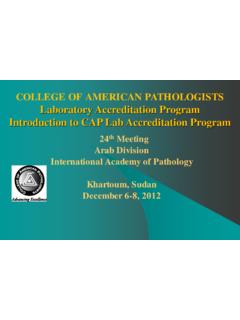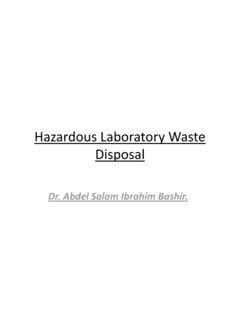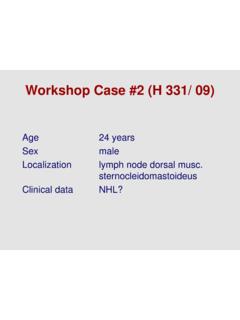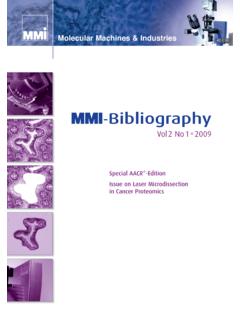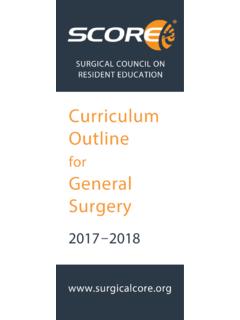Transcription of Molecular Pathology of Sarcomas: Diagnostic and ...
1 Molecular Pathology of sarcomas : Diagnostic and Therapeutic Utility Meera Hameed MD Role of a Pathologist Custodians and Curators of tumor Diagnostic specimens Appreciation of Pathogenesis Determination of sub types Appropriate Molecular Testing for Diagnosis, Prognosis and Therapeutics Critical Role in Sarcoma clinical team to streamline therapeutic strategies Conventional Pathology - sarcomas Sarcoma Tumors derived from mesenchymal lineage Tumors resemble normal counterpart Eg., Leiomyosarcoma-Liposarcoma No normal counterpart Eg., Ewing Sarcoma, Synovial Sarcoma Cell of Origin Primitive Mesenchymal Cell? sarcomas -Clinical Management sarcomas Low Grade High Grade Wide Local Excision Wide or Radical Excision Behavior: Indolent to highly invasive to metastatic Prognosis: Age, tumor size, grade, depth, histological subtypes Chemotherapy Gastrointestinal Stromal tumor (GIST) Ewing Sarcoma Rhabdomyosarcoma Synovial Sarcoma Myxoid Liposarcoma Malignant Fibrous Histiocytoma Sensitive Liposarcoma(other types)
2 Myxofibrosarcoma MPNST Leiomyosarcoma Intermediate Chondrosarcoma Clear Cell Sarcoma Epithelioid Sarcoma Rhabdoid tumor Alveolar Soft Part Sarcoma Resistant Histology driven Chemotherapy- Important for targeted and non-targeted therapy Diagnosis of sarcomas Diagnosis/ Staging Prognosis Traditional Pathology Immunohistochemistry Molecular Pathology Diagnosis and direct treatment Molecular Pathology of sarcomas Specific Translocations or gene amplification Defined by Oncogenic gene mutations Complex karyotypes/genomic rearrangements Diverse tumors in each class Molecular Pathology - sarcomas Translocation associated sarcomas and relatively simple Karyotypes sarcomas with complex karyotypes and no specific translocations Ewing Sarcoma/PNET Desmoplastic Small round cell tumor Alveolar Rhabdomyosarcoma Myxoid Liposarcoma Extraskeletal myxoid Chondrosarcoma Clear cell sarcoma (soft tissue) Angiomatoid fibrous histiocytoma Congenital/infantile Fibrosarcoma Low grade fibromyxoid sarcoma Inflammatory myofibroblastic tumor Alveolar Soft Part Sarcoma Synovial Sarcoma Epithelioid Hemangioendothelioma Epithelioid Sarcoma Leiomyosarcoma Myxofibrosarcoma Adult fibrosarcoma Liposarcomas other than myxoid liposarcomaEmbryonal and pleomorphic rhabdomyosarcoma Osteosarcoma Angiosarcoma Undifferentiated Pleomorphic sarcoma Amplification associated- Liposarcoma- Angiosarcoma Mutation Driven- Gastrointestinal Stromal tumor Molecular Pathology - sarcomas Ewing Sarcoma/PNET- First discovered translocation associated sarcoma t(11;22)(q14;q22) (EWS-FLI1) New Eng J Med, 309; 496-498, 1983 Sarcoma Type Translocation Fusion gene Year Ewing Sarcoma t(21;22) EWSR1-ERG 1993 Clear Cell Sarcoma Myxoid/round cell Lipoarcoma t(12;22) t(12;16) EWSR1-ATF1 FUS-DDIT3 1993 1993 ARMS DSRCT t(2;13) 13) t(11;22) PAX3&PAX7-FOXO1A EWS-WT1 1994 Extraskeletal Myxoid Chondrosarcoma t(9;22) t(9.
3 17) EWSR1-NR4A3 EWSR1-TAF2N 1995 1999 Synovial Sarcoma t(X;11) SYT-SSX1 and SSX2 1995 DFSP t(17;22) COL1A1-PDGFB 1997 Congenital fibrosarcoma t(12;15) ETV6-NTRK3 1998 IMT t(2p23) Alk Fusions (many partners) 2000 Alveolar Soft Part Sarcoma t(X;17) ASPL-TFE3 2001 Low Grade Fibromyxoid sarcoma t(7;16) FUS-ATF1 2003 Angiomatoid Fibrous Histiocytoma t(12;16) t(12;22) FUS-ATF1 EWSR1-ATF1&CREB1 2000 2007 sarcomas with simple karyotypes- Pathology Perspective Round Cell Spindle Cell Epithelioid Cell Immunohistochemistry- Generally non-lineage specific (overlapping) Molecular Testing Translocation associated sarcomas tumor Type Translocation Fusion gene(s) Alveolar Soft Part Sarcoma der(17)t(x;17) ASPL-TFE3 Alveolar Rhabdomyosarcoma t(2;13) 13) PAX3-FOXO1 &PAX7-FOXO1 Angiomatoid Fibrous Histiocytoma t(2;22) , t(12;22) 16) EWSR1-CREB1, EWSR1-ATF1 &FUS-ATF1 Clear Cell Sarcoma t(12;22) 22) EWSR1-ATF1 &EWSR1-CREB1 Congenital infantile fibrosarcoma t(12;15) ETV6-NTRK3 Dermatofibrosarcoma Protuberans t(17;22) COL1A1-PDGFB Desmoplastic small round cell tumor t(11;22) EWSR1-WT1 Endometrial Stromal sarcoma t(7;17), t(6;7) 10) JAZF1-SUZ12, JAZF1-PHF1 &EPC1-PHF!
4 Ewing Sarcoma/PNET t(11;22), t(21;22), t(7;22), t(2;22), inv(22), t(6;21) EWSR1-FLi1, EWSR1-ERG, EWSR1-ETV1. EWSR1-E1AF. EWSR1-FEV. EWSR1-ZSG &FUS-ERG Extraskeletal myxoid chondrosarcoma t(9;22), t(9;17), t(9;15) EWSR1-NR4A3, RBP56-NR4A3, TCF12-NR4A3, TFG-NR4A3 Inflammatory myofibroblastic tumor t(3;9), t(1;2), t(2;19), t(2;17), t(2;2), t(2;17) TPM3-ALK, TPM4-ALK, CLTC-ALK,RANBP2-ALK Low grade Fibromyxoid sarcoma t(7;16) 16) FUS-CREB3L2 &FUS-CREB3L1 Myxoid-Round cell Liposarcoma t(12;16) 22) FUS-DDIT3 &EWS-DDIT3 Epithelioid Hemangioendothelioma t(1;3)(p36;q25) WWTR1-CAMTA1 Synovial Sarcoma t(X;18) 20) SS18-SSX1, SS18-SSX2, SS18-SSX4 &SS18L1-SSX1 Molecular Testing in sarcomas - Caveats Infidelity in Chromosomal Translocations Site Translocation Gene Fusion tumor Type Site/Organs t(12;15) ETV6-NTRK3 Infantile Fibrosarcoma Mesoblastic Nephroma Secretory carcinoma breast Salivary gland carcinoma-mammary analog AML Soft Tissue Kidney Breast Salivary Gland Blood 17) ASPL-TFE3 Alveolar Soft Part Sarcoma Renal Cell Carcinoma Subset of PECOMAs Soft Tissue Kidney Soft tissue t(1:2) TPM3-ALK Inflammatory myofibroblastic tumor (IMT) Anaplastic Large Cell Lymphoma (ALCL) Soft tissue, abdomen Skin, Lymph nodes t(12;22) t(2;22) EWSR1-ATF1 EWSR1-CREB1 Angiomatoid Fibrous Histiocytoma &Clear Cell Sarcoma Soft Tissue tumor Type Translocation Fusion genes Ewing Sarcoma t(11;22)(q24;q12) t(21;22)(q22;q12) t(7;22)(q22;q12) t(17;22)(q12;q12) t(2;22)(q31;q12) t(2;22)(q33;q12) t(1;22)( ;q12) t(20;22)(q13;q12) (inv)22 EWSR1-FLI-1 EWSR1-ERG EWSR1-ETV1 EWSR1-E1AF EWSR1-SP3 EWSR1-FEV1 EWSR1-ZNF278 EWSR1-NFATC2 EWSR1-ZSG Angiomatoid Fibrous Histiocytoma t(12;22)(q13;q12) EWSR1-ATF1 Clear cell Sarcoma t(12;22)(q13;q12) EWSR1-ATF1 Desmoplastic Small Round Cell tumor t(11.
5 22)(p13;q12) EWSR1-WT1 Extraskeletal myxoid chondrosarcoma t(9;22)(q22;q12) EWSR1-NR4A3 Myxoid/round cell liposarcoma t(12;22)(q13;q12) EWSR1-DDIT3 Myoepithelioma t(19;22)(q13;q12) t(1;22)(q23;q12) t(6;22)(p21;q12) EWSR1-ZNF44 EWSR1-PBX1 EWSR1-POU5F1 EWSR1 is a sort after Gene for Sarcoma Translocations Ewing Sarcoma/PNET DSRCT Neuroblastoma Non-Hodgkin Lymphoma Synovial Sarcoma CD99 Sensitive but not a specific Marker tumor CD99 Fli1 LCA B T TdT CK Chr S-100 Des Myogenin WT1 Ewing/ PNET + + - - - - +/- - +/- - - - LBL/ALL + + +/- +/- +/- + +/- - - - - +/- NHL-other +/- + + + + - - - - - - - + - - - - - - - + +/- +/- - Small Cell OS +/- - - - - - +/- - +/- +/- - - Rhabdomyosarcoma +/- - - - - - - - - + + +/- cyto) DSCRT + - - - - - + - +/- + - + Neuroblastoma - - - - - - +/- + +/- - - - Immunohistchemical Profile of Round Cell Tumors Ewing Sarcoma EWS-FLI1 Gene Fusion Chromosomal Translocation + Control RNA - RNA - tumor + Control tumor + Control Ewing Sarcoma with Type I fusion EWING SARCOMA-RT-PCR Variant Fusions.
6 EWSR1-ERG, EWSR1-ETV1, EWSR1-E1AF, EWSR1-FEV, EWSR1-ZSG &FUS-ERG Fluorescence in situ hybridization detection of chromosomal translocations Translocation Normal Gene 1 probe Gene 2 probe Gene 1B probe Gene 1A probe Fusion Assay Splitting Assay Ewing Sarcoma diagnosis by Fluorescent in-situ Hybridization Molecular Testing for sarcomas -What can the Pathologist provide? Diagnosis Round Cell Neoplasms: Ewing vs DSRCT vs Small Cell OS vs Poorly Differentiated Synovial Sarcoma vs. Alveolar Rhabdomyosarcoma vs. Neuroblastoma Spindle cell neoplasms- Confirm Synovial Sarcoma Benign or Malignant: Low Grade Fibromyxoid Sarcoma vs Perineurioma vs low grade myxofibrosarcoma vs. fibromatosis 25 year old female with a soft tissue mass of left leg Myxofibrosarcoma Fibromatosis Perineurioma Low Grade Fibromyxoid sarcoma Low Grade Fibromyxoid Sarcoma Translocation associated sarcoma-t(7;16)(q33;p11)- FUS-CREB3L2 FUS break apart Probe with Split Signal FUS break apart Probe with Split Signal Outcome of Chromosomal rearrangements Promoter A Promoter A Promoter A Promoter A Promoter B Promoter B Coding Sequence A Coding Sequence A Coding Sequence B Coding Sequence B Coding sequence A Coding Sequence B Coding Sequence B Adapted from Mertens et al.
7 , Sem in Oncol 36,( 4):2009. Deregulated Gene Fusion Gene Can Fusion genes be Targeted? Promoter A Promoter A Promoter A Promoter A Promoter B Promoter B Coding Sequence A Coding Sequence A Coding Sequence B Coding Sequence B Coding sequence A Coding Sequence B Coding Sequence B Deregulated Gene Fusion Gene Targeted Therapy Translocation-associated sarcomas tumor Type Dermatofibrosarcoma Protuberans (DFSP) Inflammatory Myofibroblastic tumor (IMT) Diffuse type Tenosynovial Giant Cell tumor (PVNS) Fusion gene- Target COL1A1-PDGFB Imatinib Multiple Partners-ALK- Crizotinib COL6A3-CSF1- Imatinib Targeted Therapy Translocation associated sarcoma Promoter A Promoter A Promoter B Coding Sequence A Coding sequence A Coding Sequence B Coding Sequence B Fusion Gene Elusive Few down stream Targets Alveolar Rhabdomyosarcoma- PAX3-FOXO1A Ewing Sarcoma EWSR1 and FUS- IGF1R Alveolar Soft Part Sarcoma- ASPS-TFE3 Clear Cell Sarcoma- EWSR1-ATF1 or CREB1 MET Synovial Sarcoma SS18-SSX1 or SSX2 FGFR - PDGFRA Molecular sarcomas with Driver Mutations Gastrointestinal Stromal tumor (GIST) The most common sarcoma of GI tract Most Common Location.
8 Stomach, Small Bowel Also abdomen, mesentery and extra-GI GIST Annual Incidence-4000-5000 cases in United States Cell of Origin- Interstitial Cells of Cajal ( GI pacemaker cells ) Mutations in C-kit gene, less commonly PDGFR- Alpha and rare BRAF mutation (7% of GIST pts) Leading model for kinase-targeted therapy GIST-Spindle Cell Type GIST-Epithelioid Type C-Kit C-kit/CD-117 CD-117/C-Kit is a class III receptor tyrosine kinase Location: chromosome 4q12-13 close to PDGFRA and FLK1 receptor tyrosine kinases Role: normal development and function of ICC, hematopoiesis, gametogenesis and melanogenesis Activating kit mutations : GIST, seminomas, AML, melanomas, mastocytosis and some thymomas Membrane Receptor Kinases Cell Signal. 2009 Dec;21(12):1717-26. Epub 2009 Jun 18. C-Kit Signaling Pathway Kit and PDGFRA mutations in GIST (adapted from Heinrich et al ASCO, 2003) Diagnosis of GIST Strong C-kit immunoreactivity Activating mutations exons 9 and 11 - 80% Rare mutations exons 13 and 17 PDGFRA (exons 12,14,18)- 10-15% No mutation ~ 10% C-Kit IHC negative GIST (4%)- usually PDGFRA mut GIST with no known mutations Pediatric GIST multifocal gastric- indolent GIST associated with Neurofibromatosis -1 Types of Kit Mutations Common Site is 5 end of exon 11- hot-spot Point Mutations In-frame deletions Deletions Substitutions Less common site-3 end of exon 11- Internal tandem duplications (ITD)
9 Do worse Indolent Exon 9- at EC domain-insertion of two AA, AY502-3- small bowel More Aggressive PDGFRA mutations One-third of GISTS lacking in Kit mutations Exons 12, 14 or 18 Gastric Location, epithelioid morphology Variable IHC expression for C-kit Indolent behavior Hot spot- second kinase domain (exon 18- D842V) Insensitive to Imatinib therapy GIST-Indications for mutation Testing NCCN Task Force Report -2010 High-Risk GISTs (>5 cm and >5 mitoses/50 high power fields) Metastatic GISTs GISTs which are negative for C-kit by immunohistochemistry GISTs with epithelioid morphology Small bowel GISTs GISTs resistant to imatinib Testing Algorithm for C-kit and PDGFRA GIST tumor TISSUE Exon 11 Exon 9 Fragment Analysis C-kit -Capillary Electrophoresis Negative Negative Exon 11 Sequence Analysis Exon 13 Sequence Analysis Exon 9 Sequence Analysis Negative PDGFRA exons 12 and 18 Sequence Analysis Molecular Testing for Second Site Mutation Imatinib resistant GIST C-Kit Exon 13,14 Sequence Analysis C-Kit Exon 17 Sequence Analysis , (GCCTAT) Exon 9 Fragment Analysis Exon 9 Sequencing Kit mutation exon 17- Resistance Mutation T>C Normal Forward Normal-Reverse tumor -Forward tumor -Reverse G>A GIST- Targeted Therapy Imatinib mesylate (STI571, Gleevec)
10 Is a selective tyrosine kinase inhibitor Targets Kit and PDGFRA Partial response or stable disease in 80% of patients with metastatic GIST Pathological response is necrosis and fibrosis and is heterogeneous Half of the patients will develop drug resistance Usually due to second site kit mutation Half of the resistant cases, no secondary mutations are identified sarcomas with Specific Amplifications Retroperitoneal Liposarcoma sarcomas with Specific Amplifications-Well-Differentiated and Dedifferentiated Liposarcoma Retroperitoneal Liposarcoma-WDLS 12q13-15 amplicons (MDM2,HMGA2 and CDK4 genes) Retroperitoneal liposarcoma -Dedifferentiated 12q13-15 amplicons (MDM2,HMGA2 and CDK4 genes) CDK4 MDM2 INK4a/ P16 ink4a p14 ARF CyclinD1 CDK4 MDM2 p21cyp1 Rb E2F Rb E2F p53 VEGF p16 Ink4a p16 Ink4a p16 Ink4a CDK4 AE1 p53 E6 Apoptosis Rb E7 p p G1 S M G2 G0 Nucleus Cell Invasion Cytoplasmic Sequestration Angiogenesis Inhibition DNA damage, mitogenic stimulation, oxidative stress etc.
